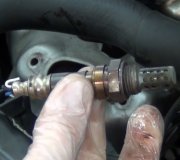I know the lefts and rights will be the same but I checked at rockauto. Com to verify they are different from the rears, and they are. I was surprised to see that they are very inexpensive. Lucky you!
To add to the story, you should have a Check Engine light on if any one of those sensors isn't doing its thing. If you watch the switching rate with a scanner, the front sensor, (upstream / in front of the catalytic converter) should switch between "rich" and "lean" as much as two or three times per second. Over a period of time that averages out to a perfect air / fuel mixture ratio, but during the lean pulses, extra unburned oxygen is stored in the catalyst. During the rich pulses the unburned fuel is mixed with that oxygen and burned. A constant perfect mixture at all times is ideal with the old carburetors, but with fuel injection we need to see the changes from rich to lean to verify the Engine Computer has control over that mixture.
When the catalytic converter is doing its thing the gas leaving it is neither real rich nor real lean. In fact, it will swing between a little bit rich or lean VERY slowly, as in perhaps once or twice a minute. The secret is the computer looks at those two switching rates and compares them. Front one real fast means that sensor is working. Rear one real slow means the catalytic converter is working. When the converter loses its efficiency, no change takes place in the composition of the exhaust gas so the rear switching rate is almost as fast as the front one. That's how the computer determines if the converter is doing its job. The front one has a very tiny affect on engine performance, in fact it's almost unnoticeable, and it won't even be in the picture yet until it gets up to operating temperature of 600 degrees. The rear sensor has no affect on engine performance at all. It is strictly to monitor catalytic converter efficiency.
One thing to be aware of that can be real frustrating for mechanics who have to provide estimates for their customers is in your case with four bad sensors, you likely will not get four diagnostic trouble codes. You can get all four if the problems are intermittent and act up at different times, but usually you'll only get one code if they act up at the same time. The reason is the Engine Computer looks at a lot of different things to compare to know when to set a code. Every code has a long list of criteria that must be met before it will set, and one of those things is certain other codes can not already be in memory. On some models they can be "history" codes but if the problem is currently acting up, other codes that need to set may not.
As an example, the computer knows that after the engine has been off at least six hours, the coolant temperature sensor and the intake air temperature sensor had better be reading the same temperature. That's how it self-adjusts its expectations when you stick in one new sensor. If a code is set for the coolant temperature sensor, the computer knows it can't use its value to compare to the intake air temperature sensor, so unless there's a real bad situation, no code will be set if the intake air temperature sensor fails. That code WILL set after the coolant temperature sensor is replaced and the code is erased. This type of situation gives GM mechanics real headaches with anti-lock brake wheel speed sensors. Replace the one with a code, then a new code pops up and they have to tell the customer more parts are needed. Very frustrating for mechanics and owners.
Getting back to your car, if the Check Engine light is not on, all four O2 sensors are working. If the light is off while driving there could be stored code(s) but the problem is not acting up now. If the light is on while driving there will be at least one code, but the problem doesn't necessarily have to be occurring right now.
Normally if you have a code for a front O2 sensor you won't have one for the rear sensor on the same side of the car because the computer has nothing to compare it to and it knows it has lost control of the mixture reading in front so it can't expect the gas coming out of the catalytic converter to be right. In that case I would start with just the sensor indicated by the code. Lets say the code is for the left front one; that would be "bank 1 sensor 1". Replace it, erase the code(s), drive it until the Check Engine light turns on again, then go according to the next code. Keep in mind too that if the front sensor is reporting bad or no information to the computer, the computer is going to look at any good information from other sensors to adjust fuel metering as best as possible, and that can affect other things, in this case the readings from the rear O2 sensors. You could have multiple O2 sensor codes, one for the front sensor and one for the rear sensor, and just a new front sensor might solve both codes. That's why I would start with just one new sensor but don't get discouraged if you end up buying more.
Saturday, September 29th, 2012 AT 12:12 AM



